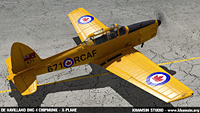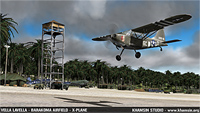INSTRUMENTS
COCKPIT - FORWARD VIEW (TYPICAL)

- 1. Field Of View SELECTOR This allows you a one-click toggling from "Wide" to "Normal" or "Tele" field of view. Very useful when approaching a carrier for instance
- 2. STALL WARNING TEST SWITCH This switch is intended, IRL, to test the warning stall bipper. It's useful in game to disconnect the autopilot.
- 3. LANDING LIGHTS SWITCHES The Left and Right landing lights can be operated separately. NB : the "ext" switch, on the left panel, must be ON for the landing lights to light on.
- 4. GEAR HANDLE Guess by yourself what it's for...
- 5. FUEL LOW-LEVEL WARNING LIGHT These lights will turn on when there is 30mn of fuel left (depending on your attitude)
- 6. WINDSHIELD AND CANOPY DEFROST - CONTROL HANDLE
- 7. GEAR LOCK INDICATOR This does not display the position of the gears, but wether each gear is LOCKED or not.
- 8. ILS & Runway Heading, BEACON MARKER The ILS is automatically controlled by the NAV1 frequency you dialed on the navigation panel. The up-left light turns on when a glide-slope is caught, the up-right light turns on when a path is caught. The lower_left light turns on when the plane flies over a beacon marker (middle). The digital display gives the absolute heading of the LOC the ILS is tuned to, tha is, the heading of the runway (as for carier, it's not the carrier headin, but carrier heading minus 8 degrees)
- 9. AIRSPEED INDICATOR In knots. The main speeds to be known are : Vref=59kt (no payload, full flaps), 90kts (take-off speed, V2), 140kts (max speed with gear down or flaps down), 185/225 kts (cruise speeds), 343kts - Vne.
- 10. COURSE INDICATOR
- 11. GYRO HORIZON INDICATOR
- 12. MANIFOLD PRESSURE INDICATOR AND DEPRESS BUTTON You should care about this one. When flying, never drop below 25 inches, never set more than 52.5 inches. Max continuous is 47 inches, up to 52.5 for 5 minutes, but you should fly at atmospherical pressure + 5 inches most of the time. That's around 35 inches at sea level, when cruising, or 30 inches with high-blower above 15000ft.
- I3. RADIO MAGNETIC INDICATOR The double arrow is driven by the autopilot heading setting. The needles #1 & #2 are driven by the NAV1 and NAV2 frequencies, so #1 points toward the carrier if the NAV1 is set to 108.10
- I4. ALTIMETER
- I5. SLIDE INDICATOR
- I6. VERTICAL SPEED INDICATOR
- I7. RPM GAUGE The engine can withstand up to 2700rpm for a short period of time, but the usefull range stretch from 1600rpm (high altitude cruise) to 2400 rpm (Climbing)
- I8. FLAPS DEPLOY INDICATOR Indicates the actual position of the flaps. When the needles is below the "up" position, flaps are locked. Maximum allowable speed with flaps deployed is 140 knots.
- 19. ACCELEROMETER Never exceed 5G. Don't forget that stall speeds depend on the G-factor.
- 20. CLOCK
- 21. OIL TEMPERATURE GAUGE
- 22. CYLINDER HEADS TEMPERATURE GAUGE This one is of major interest. Make sure the needle never goes outside the green arc !
- 23. GENERATOR VOLTMETER
- 24. FUEL QUANTITY GAUGES The plane carries up to 1062 lb of fuel, allowing a rough 4 hours airborne.
- 25. ARMAMENT PANEL To release bombs, first set the armament selector to "ON", then set a mode : single, pair, salvo.Now press the action key (space is defaut)
- 26. OIL PRESSURE INDICATOR
- 27. FUEL PRESSURE INDICATOR
- 28. HOOK HANDLE The hook produces no noticeable drag.
- 29. OXYGEN DILUTER
- 30. OXYGEN PRESSURE GAUGE
- 3I. MAGNETO HANDLE
- 32. OXYGEN BLINKER
- 33. PARK BRAKE HANDLE
LEFT CONSOLE

- 1. COCKPIT AIR CONTROL HANDLE #
- 2. FUEL SHUTOFF HANDLE Caution : Boost pump and fuel valve are linked. When you shut off the fuel boost pump, the fuel valve is closed.
- 3. HYDRAULIC HAND-PUMP #
- 4. AILERON TRIM WHEEL It will be very usefull to have a shortcut for this on either your joystick or your keybord.
- 5. CARBURETOR AIR CONTROL Rear and up collects outside (cold) air, forth and down collects hood (hot) air. Any position in between is allowed. Caution : full forward lowers the power of the engine, down to a loss of 300 horse-powers.
- 6. ELEVATOR TRIM WHEEL It will be very usefull to have a shortcut for this on either your joystick or your keybord.
- 7. RUDDER TRIM WHEEL It will be very usefull to have a shortcut for this on either your joystick or your keybord.
- 8. CANOPY CONTROL HANDLE Canopy should be open for any near-ground operation. Caution : it gives tons of drag ! Opening the canopy will evacuate smoke, too.
- 9. FRICTION LOCK KNOB #
- 10. FLAPS HANDLE
- 11. BLOWER HANDLE Toggles the supercharger. Caution : never use below 10000ft, as it is likely that would blow the manifold pressure, resulting in engine seizing, shaft blast, engine fire...
- 12. THROTTLE
- 13. SPEED BRAKE COMMAND It will be very usefull to have a shortcut for this on either your joystick or your keybord.
- 14. RADIO SWITCH #
- I5. PROPELLER SPEED HANDLE Useful range for this is 1900-2400 rpm. Set to 2600 for carrier landing.
- 16. HYDRAULIC SYSTEM PRESSURE GAGE If you have no hydraulic, you loose brakes, flight controls, and gears.
- 17. COWL AND OIL COOLER FLAP SWITCH Managing this can be tricky. It's very efficient to cool the engine, but it provides lots of drag, thus slowing the aircraft, what make temperature go higher.
- 18. COCKPIT HEATER CONTROL #
- 19. Field Of View SELECTOR
- 20. STALL WARNING TEST SWITCH
- 21. LANDING LIGHT SWITCHES
RIGHT CONSOLE (FRONT COCKPIT)

- 1. AVIONICS MASTER SWITCH This switch toggles power supply for the whole navigation panel. It requires the primary bus to be supplied with electricity, AND the inverter to be ON. If the inverter is NOT on OR if it is out of order, the avionics will not function at all.
- 2. TRANSPONDEUR Pressing on each button will increase the corresponding figure by 1 increment, for instance, pressing the 2nd button will increase hundreds from X3XX to X4XX. The buttons work only in the incresing direction.
- 3. DUAL ADF-NDB Both ADF are "active". There is no "stand-by" mode. The needle gives absolute bearing to the nearest NDB corresponding to the selected frequency.
- 4. UHF RADIO CONTROL PANEL Com1 and Com2 are unnecessary to fly. Actually, whatever you set, you can contact ATC. As this might change in Xplane10, 2 operationnal Com radios are supplied.
- 5. NAVIGATION FREQS CONTROL PANEL Both Nav are "active". there is no stand-by mode. The Nav1 frequency controls both the RMI needle #1 and the ILS display. Each button increase either units or decimals. The special button "CARRIER" sets the carrier ils frequency in one-click, thus the RMI #1 points toward the nearest carrier, the ils sets itself to the glide pattern of the carrier.
- 6. AUTOPILOT
The autopilot is simple but robust. It allows the use of 4 modes :
- Attitude
- Leveled flight
- Speed with climb
- Heading
- 7. ELECTRICAL SWITCH PANEL On the switch panel, labels are quite self-explainatory. Simply note the "ext" button that allows the secondary bus (external supply) to be set ton "on", and the duo inverter/generator, which use is mandatory in flight.
- 8. PARK BRAKE HANDLE Probably you have an idea of its use :-) Anyway, please note that brakes are hydraulic.
- 9. IGNITION SWITCH Allows starting sequence to be efficient.
- 10. OXYGEN BLINKER This will blink more and more as the oxygen supply is used.
- 11. CIRCUIT BREAKER PANEL Inopperant.
"M" Stands for MASTER. If you press this button and this button only, the plane will try and hold her current attitude : pitch, roll, yaw.
"H" Stands for HEADING. The plane will turn to, then maintain, the direction that is set on the large compass on the autopilot console, represented by the double-needle. You can set the desired value with the button HDG+ and HDG-.
"S" Stands for SPEED. Actually it is "speed with climb", rather than "flight level change", as it works UPWARDS and not DOWNWARDS. If You engage this mode, 2 behaviours are possible : if the dialed flight level is ABOVE your current altitude, the plane will climb up to this FL, then level and accelerate. If the dialed flight level is BELOW your current altitude, the plane will immediately level and accelerate.
So, if you want to level your plane immediately, turn on S mode, then set a FL below you. If you want to go down, FIRST, set a FL below you, THEN engage S mode, THEN reduce thrust.
www.khamsin.org - © 2013



